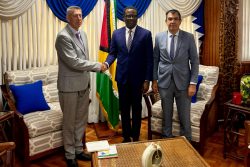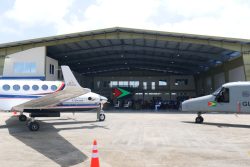There were two major official celebrations along with a less publicised third event on Arrival Day this year. It is just that the last named was the only one which related to the designation of the day as such; the other two were specifically about Indian Arrival. Where these were concerned one was at Palmyra and the other at Highbury in Berbice, while the only Arrival Day event per se took place in the Indian Monument Gardens in Georgetown. Here the main speaker was Prime Minister Mark Phillips who addressed himself to the contributions of the indentured workers as a whole, although the ceremony was organised by the Indian Commemorative Trust which has been mounting its Pushpanjali celebrations there on May 5 for more than twenty years.
The proverbial man from Mars might wonder why two major Indian Arrival Day ceremonies in Berbice should have been held so close to one another in terms of distance. The short answer is PPP myopia. The first Indians to this country arrived on the Hesperus and the Whitby on May 5, 1838. There were approximately 423 of them in total, but the last named vessel made land first at the plantation of Highbury, where the initial complement of indentured labourers came down the gangway to set their feet on Guyana soil.
Not surprisingly, therefore, Highbury has long been seen as the starting point of the Indian story here, and those first immigrants as symbolically speaking the pioneers of this nation’s largest ethnic group. As such, celebrations have been taking place here for some time to commemorate those first arrivals, and when the question of a monument to Indian arrival in Guyana came up, the assumption was that this former plantation would be its obvious location.
In a generous act the Indian government donated the money for a monument, and also had it cast in bronze after it had been designed by Philbert Gajadhar and Winslow Craig. But the government decided to place it at Palmyra, not Highbury, despite objections from leading members of the Indian community.
But then the PPP does not have a very good record where the siting of monuments in general is concerned. Earlier there had been the case of the 1823 monument, when Mr Jagdeo had assured African cultural groups it would be placed at the Parade Ground/Independence Park which has a tragic association with the rising. But in a sudden volte face the government decided to mount it instead by the seawall. As is their wont there was no prior consultation with the African community, or any really coherent explanation as to why they had gone back on their word.
In the case of the Indian Arrival monument the public was told that it would be in a much more prominent place at Palmyra than Highbury, and would be far more visible. That is true, but nevertheless the governing party would have found that people would have still made the trek to Highbury to see it, whatever the state of the east bank road which was another reason given for not erecting the monument there. As it is, the presence of the monument in Palmyra has not discouraged anyone from going to Highbury instead on May 5, including a whole bevy of government ministers. Indian High Commissioner. Dr K J Srinivasa spoke here too, as well as at Palmyra.
However, the situation is as it is, and Palmyra cannot be ignored on an important date like May 5. Since government associated commemorations seemed to centre on Highbury, it was the Guyana Hindu Dharmic Sabha in conjunction with the Indian High Commission which took on the elaborate ‘Sanskriti’ celebrations of heritage and culture at the monument. This meant too that Dr Vindhya Persaud, President of the Dharmic Sabha could also represent the government since she is the Minister of Human Services and Social Security.
But there still remains the matter of Arrival Day, which is a misnomer. Many groups came to Guyana in the nineteenth century, but most of them in such small numbers, like the Syrians (called Lebanese elsewhere in the Caribbean) that they do not qualify for a designated national day. And it is all about numbers. The three largest groups were the Indians, the Portuguese and the Chinese, in that order, with Indian totals way in excess of any others. In addition, their descendants today still comprise the largest of all the ethnic groups, including the Africans and the Indigenous, and their culture has consequently made a huge impact on this land and its people. Their heritage and contributions simply cannot be overlooked, and neither should they be conflated with those of the other arrival groups.
While the Portuguese have left their mark on the culture of this nation, their descendants for the most part have decamped to other climes, in addition to which many of the Chinese too did not stay. That said, it does not mean that members of those groups should forget when their forebears arrived and subsume their legacy and memories under those of the Indians. In fact the Chinese have their own monument in the compound of the Windsor Forest Primary School. It was erected in 1986 by the Guyana China Friendship Society to commemorate the arrival of the first Chinese on the Glentanner. It was an all male complement and the initial group to disembark was sent to Windsor Forest. Just as the Indians feel a psychological bond with Highbury, so the Chinese feel the same towards Windsor Forest. Their arrival date was January 12, 1853.
The Portuguese do not have a monument, but they too are in no doubt about their correct date of first arrival, and it is not May 5, 1838. Their forebears first came three years before the Indians, on May 3, 1835. According to Prof Noel Menezes, 40 Madeirans arrived on the Louisa Baillie bound for Pln Thomas and Plns La Penitence and Liliendaal.
National celebrations of any kind were very much in abeyance during the Covid restrictions, but now that they are back there has been a renewed call for Arrival Day to be more accurately redesignated ‘Indian Arrival Day’. Former President Granger, who whatever else might be said of him certainly had a grasp of the historical data had issued two public notices in 2017 designating January 12 as Chinese Arrival Day and May 3 as Portuguese Arrival Day. This makes it so much easier for the government to do the obvious and now rename May 5 as Indian Arrival Day.
It is not as if there will be any resistance from the opposition. In a press release last week, they cited Mr Granger’s public notices in relation to the Portuguese and Chinese and called for the May 5 observances to be named ‘Indian Arrival Day’. “Given these changed circumstances surrounding the original purpose of Arrival Day coupled with the fact that Guyanese of African and Amerindian origin have designated days or months to celebrate their distinct heritages the PNCR hereby joins the call for the May 5th observances to be officially recognized henceforth as Indian Arrival Day”, the party said in a release.
So what excuse does the PPP/C have for delaying any longer, apart from their notorious reluctance to reverse themselves on even the most minor of matters?
No one knows why they settled on the Arrival Day designation in the first place, other than the fact that for them everything that happened before 1953 is a historical blur. Everyone hopes that by the time the next May 5 rolls around they will have abandoned their customary ahistorical posture.







